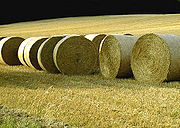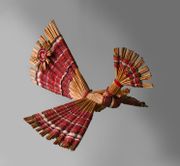Straw
Not to be confused with hay.

Bales of straw

bundles of rice straw

Pile of straw bales, sheltered under a tarpaulin
Straw is an agricultural by-product, the dry stalks of cereal plants, after the grain and chaff have been removed. Straw makes up about half of the yield of cereal crops such as barley, oats, rice, rye and wheat. It has many uses, including fuel, livestock bedding and fodder, thatching and basket-making.
Uses
- Biofuels
- The use of straw as a carbon-neutral energy source is increasing rapidly, especially for biobutanol.
- Biomass
- The use of straw in large-scale biomass power plants is becoming mainstream in the EU, with several facilities already online. The straw is either used directly in the form of bales, or densified into pellets which allows for the feedstock to be transported over longer distances. Finally, torrefaction of straw with pelletisation is gaining attention, because it increases the energy density of the resource, making it possible to transport it still further. This processing step also makes storage much easier, because torrefied straw pellets are hydrophobic. Torrefied straw in the form of pellets can be directly co-fired with coal or natural gas at very high rates and make use of the processing infrastructures at existing coal and gas plants. Because the torrefied straw pellets have superior structural, chemical and combustion properties to coal, they can replace all coal and turn a coal plant into an entirely biomass-fed power station. First generation pellets are limited to a co-firing rate of 15% in modern IGCC plants.
- Bedding humans or livestock
- The straw-filled mattress, also known as palliasse, is still used in many parts of the world.
- It is commonly used as bedding for ruminants and horses. It may be used as bedding and food for small animals, but this often leads to injuries to mouth, nose and eyes as straw is quite sharp.
- Animal feed
- Straw may be fed as part of the roughage component of the diet to cattle that are on a near maintenance level of energy requirement. It has a low digestible energy and nutrient content. The heat generated when microorganisms in a herbivore's gut digest straw can be useful in maintaining body temperature in cold climates. Due to the risk of impaction and its poor nutrient profile, it should always be restricted to part of the diet. It may be fed as it is, or chopped into short lengths, known as chaff.
- Hats
- There are several styles of straw hats that are made of woven straw.
- Until about 100 years ago, thousands of women and children in England were employed in plaiting straw for making hats. These days the straw plait is imported.
- Thatching
- Thatching uses straw, reed or similar materials to make a waterproof, lightweight roof with good insulation properties. Straw for this purpose (often wheat straw]]) is grown specially and harvested using a reaper-binder.
- Packaging
- Straw is resistant to being crushed and therefore makes a good packing material. A company in France makes a straw mat sealed in thin plastic sheets.
- Straw envelopes for wine bottles have become rarer, but are still to be found at some wine merchants.
- Wheat straw is also used in compostable food packaging such as compostable plates. Packaging made from wheat straw can be certified compostable and will biodegrade in a commercial composting environment.[1]
- Paper
- Straw can be pulped to make paper.
- Archery targets
- Heavy gauge straw rope is coiled and sewn tightly together. This is no longer done entirely by hand, but is partially mechanised.
- Horse collars
- Working horses are making a comeback, and there is a need for horse collars stuffed with good quality rye straw.
- Construction material: bricks / cob
- In many parts of the world, straw is used to bind clay and concrete. A mixture of clay and straw, known as cob, can be used as a building material. There are many recipes for making cob.
- When baled, straw has excellent insulation characteristics. It can be used, alone or in a post-and-beam construction, to build straw bale houses.
- Enviroboard can be made from straw.
- Rope
- Rope made from straw was used by thatchers, in the packaging industry and even in iron foundries.
- Basketry
- Bee skeps and linen baskets are made from coiled and bound together continuous lengths of straw. The technique is known as lip work.
- Shoes
- Koreans wear Jipsin, sandals made of straw.
- In some parts of Germany like Black Forest and Hunsrück people wear straw shoes at home or at carnival.
- Horticulture
- Straw is used in cucumber houses and for mushroom growing.
- In Japan, certain trees are wrapped with straw to protect them from the effects of a hard winter as well as to use them as a trap for parasite insects.
- It is also used in ponds to reduce algae by changing the nutrient ratios in the water.
- The soil under strawberries is covered with straw to protect the ripe berries from dirt, and straw is also used to cover the plants during winter to prevent the cold from killing them.
- Straw also makes an excellent mulch.

Belarusian Straw Bird
- Decoration
- Corn dollies
- Straw marquetry
- Harvest crosses
- Erosion control
- Burned area emergency response
- Ground cover
- In-stream check dams
See also
- Drinking straw
- Hay
- Straw (colour)
References
- ↑ Viv Biz Club: Compostable Plates